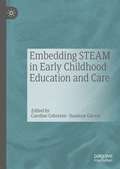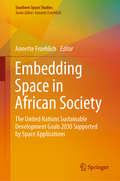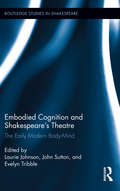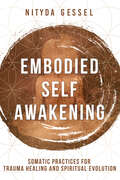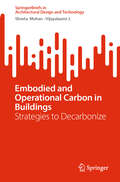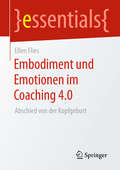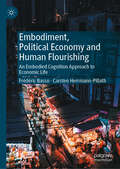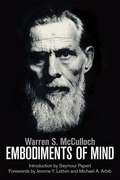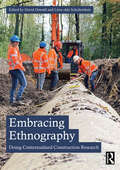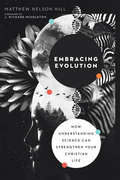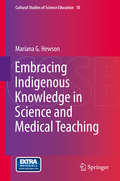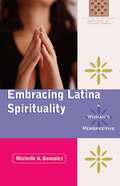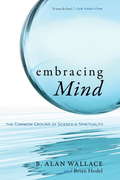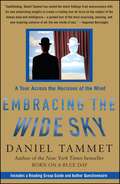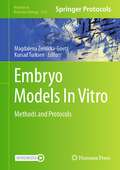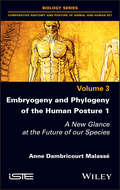- Table View
- List View
Embedding STEAM in Early Childhood Education and Care
by Susanne Garvis Caroline CohrssenThis book approaches STEAM (Science, Technology, Engineering, the Arts and Mathematics) in early childhood education from multiple angles. It focuses on the teaching and learning of children from two years of age to the early years of school. Proponents of STEAM describe how it can create opportunities for children to learn creatively, and various chapter authors make strong connections between discipline areas within the context of an informal curriculum. Others advocate for an integrated STEM, rather than STEAM, approach. With a light touch on theory and a focus on how to embed STE(A)M in an integrated early childhood curriculum, the editors and contributors examine the STEAM versus STEM question from multiple angles. The chapters provide helpful frameworks for parents, teachers and higher education institutions, and make practical suggestions of ways to support young children’s inquiry learning. Drawing on pedagogy and research from around the world, this book will be of interest to scholars of STEAM education, early childhood educators, students of early childhood education and parents of young children.
Embedding Space in African Society: The United Nations Sustainable Development Goals 2030 Supported by Space Applications (Southern Space Studies)
by Annette FroehlichThis book provides a detailed insight into how space and its applications are embedded, and can be further embedded, into African society in support of the SDGs, while taking into account the specific features, needs, and diversity of that society.Contributions drawn from across the continent and further afield provide analyses of the particular social situations in a variety of different African countries and regions, and highlight areas where space applications support the SDGs, and where they can further do so. The chapters cover a wide array of relevant and timely topics including basic needs like water quality, education, and capacity building, as well as financial, security, and legal aspects, together with facets of space technologies and infrastructure in Africa. Embedding Space in African Society will be of great interest to students and professionals in sustainable development, governance, and space studies.
Embodied Cognition and Shakespeare's Theatre: The Early Modern Body-Mind (Routledge Studies in Shakespeare)
by Evelyn Tribble Laurie Johnson John SuttonThis collection considers issues that have emerged in Early Modern Studies in the past fifteen years relating to understandings of mind and body in Shakespeare’s world. Informed by The Body in Parts, the essays in this book respond also to the notion of an early modern ‘body-mind’ in which Shakespeare and his contemporaries are understood in terms of bodily parts and cognitive processes. What might the impact of such understandings be on our picture of Shakespeare’s theatre or on our histories of the early modern period, broadly speaking? This book provides a wide range of approaches to this challenge, covering histories of cognition, studies of early modern stage practices, textual studies, and historical phenomenology, as well as new cultural histories by some of the key proponents of this approach at the present time. Because of the breadth of material covered, full weight is given to issues that are hotly debated at the present time within Shakespeare Studies: presentist scholarship is presented alongside more historically-focused studies, for example, and phenomenological studies of material culture are included along with close readings of texts. What the contributors have in common is a refusal to read the work of Shakespeare and his contemporaries either psychologically or materially; instead, these essays address a willingness to study early modern phenomena (like the Elizabethan stage) as manifesting an early modern belief in the embodiment of cognition.
Embodied Self Awakening: Somatic Practices for Trauma Healing and Spiritual Evolution
by Nityda GesselAn offering to be with, and to turn toward, the feelings from which we instinctively recoil. We have learned how to suppress our pain and deny its presence, but when we fight against our internal turmoil, glimmers of peace are short-lived. Rejecting our suffering is not a sustainable solution because trauma is held in the body. In this book, Nityda Gessel invites readers on a journey toward lasting freedom, with insights and experiential practices that marry the wisdom of Buddhist psychology, yogic teachings, and Indigenous understanding with somatic psychotherapy and neuroscience. When we heal, our actions and attitudes are not hijacked by our nervous systems as easily. We begin to feel more comfortable in our bodies; more at peace, awake, and free. With Gessel’s invitation, readers will learn to look out into the world, and see more than their own trauma reflected back.
Embodied and Operational Carbon in Buildings: Strategies to Decarbonize (SpringerBriefs in Architectural Design and Technology)
by Vijayalaxmi J. Shveta MohanThis book offers the basics of embodied and operational carbon while discussing the inclusion of carbon emission in the GBRS at global and national level. This book also critically explores the important topic of embodied and operational carbon of buildings with insights on the strategies to measure and reduce embodied carbon in buildings through a case study and application approach. This approach assesses the impact of embodied carbon on the choice of structural systems, alternate building materials, alternate building technologies and air conditioning system. The impact of these alternate measures in reducing embodied and operational carbon is analyzed by demonstrating its use on a base case building, which is similar to an existing office building in India. The quantified data enables architects and designers to make early design decisions for a more environmentally sensitive approache to sustainable building designs. This book is a valuable resource for students, researchers, and practicing architects in understanding evidence based repercussions of structural systems, use of materials, technology and air conditioning systems to design green and sustainable buildings.
Embodiment und Emotionen im Coaching 4.0: Abschied von der Kopfgeburt (essentials)
by Ellen FliesDie Zukunft des Coachings ist spannender denn je. Führungskräfte sollen einen agilen und transformativen Führungsstil einsetzen und gefragt sind Führungskräfte, die Empathie, Authentizität und Beziehungsfähigkeit mitbringen. Das neurowissenschaftlich fundierte Coaching-Format SBEAT® (Strategisch-Behavioral-Emotionsaktivierendes-Training) vermittelt auf eindrückliche Weise, wie diese für Führung zentralen Skills entwickelt und trainiert werden können. Der Schlüssel liegt in gelingender Emotionsregulation. Emotionen sind wichtige Ressourcen. Sie energetisieren unser Handeln. Sie determinieren unser Entscheiden und wirken gravierend auf persönliches Wohlergehen und auf die Beziehungsgestaltung ein. Lernen Sie in diesem essential die Arbeitsweise im SBEAT® kennen. Erfahren Sie, wie schnell und nachhaltig die Arbeit mit Embodiment funktioniert.
Embodiment, Political Economy and Human Flourishing: An Embodied Cognition Approach to Economic Life
by Carsten Herrmann-Pillath Frédéric BassoThis book presents embodied economics as a foundational alternative to behavioral economics and other projects integrating economics and psychology inspired by the computational paradigm. The 20th century witnessed the disembodiment of economic models through the intensification of mathematization and formal abstraction in economics. Even proponents of an embodied approach to cognition, such as Hayek, paradoxically championed the abstract market order as a disembodied superhuman intelligence. In the wake of groundbreaking perspectives in cognitive and social sciences, which have helped to rethink the fundamental building blocks of economics, agency and institutions, this title takes a radical turn towards embodiment. Reinstating economics as political economy, embodied economics motivates a critique of capitalism based on the analysis of disembodiment through abstraction and reactivates key critical insights into the anthropology put forward by the young Marx about contemporary economics and its conceptualizations of money, property, and labor. Based on this analysis, the authors envision a concrete utopia for an economic order centered on human dignity and care for life on Earth. This book contributes to recent discussions about behavioral, experimental and neuroeconomics and addresses a transdisciplinary audience in the social and behavioral sciences, philosophy, and the humanities.
Embodiments of Mind
by Michael A. Arbib Jerome Y. Lettvin Seymour A. Papert Warren S. MccullochWarren S. McCulloch was an original thinker, in many respects far ahead of his time. McCulloch, who was a psychiatrist, a philosopher, a teacher, a mathematician, and a poet, termed his work "experimental epistemology." He said, "There is one answer, only one, toward which I've groped for thirty years: to find out how brains work." Embodiments of Mind, first published more than fifty years ago, teems with intriguing concepts about the mind/brain that are highly relevant to recent developments in neuroscience and neural networks. It includes two classic papers coauthored with Walter Pitts, one of which applies Boolean algebra to neurons considered as gates, and the other of which shows the kind of nervous circuitry that could be used in perceiving universals. These first models are part of the basis of artificial intelligence.Chapters range from "What Is a Number, that a Man May Know It, and a Man, that He May Know a Number," and "Why the Mind Is in the Head," to "What the Frog's Eye Tells the Frog's Brain" (with Jerome Lettvin, Humberto Maturana, and Walter Pitts), "Machines that Think and Want," and "A Logical Calculus of the Ideas Immanent in Nervous Activity" (with Walter Pitts). Embodiments of Mind concludes with a selection of McCulloch's poems and sonnets. This reissued edition offers a new foreword and a biographical essay by McCulloch's one-time research assistant, the neuroscientist and computer scientist Michael Arbib.
Embodiments of Mind (The\mit Press Ser.)
by Warren S. McCullochWritings by a thinker—a psychiatrist, a philosopher, a cybernetician, and a poet—whose ideas about mind and brain were far ahead of his time.Warren S. McCulloch was an original thinker, in many respects far ahead of his time. McCulloch, who was a psychiatrist, a philosopher, a teacher, a mathematician, and a poet, termed his work “experimental epistemology.” He said, “There is one answer, only one, toward which I've groped for thirty years: to find out how brains work.” Embodiments of Mind, first published more than fifty years ago, teems with intriguing concepts about the mind/brain that are highly relevant to recent developments in neuroscience and neural networks. It includes two classic papers coauthored with Walter Pitts, one of which applies Boolean algebra to neurons considered as gates, and the other of which shows the kind of nervous circuitry that could be used in perceiving universals. These first models are part of the basis of artificial intelligence.Chapters range from “What Is a Number, that a Man May Know It, and a Man, that He May Know a Number,” and “Why the Mind Is in the Head,” to “What the Frog's Eye Tells the Frog's Brain” (with Jerome Lettvin, Humberto Maturana, and Walter Pitts), “Machines that Think and Want,” and “A Logical Calculus of the Ideas Immanent in Nervous Activity” (with Walter Pitts). Embodiments of Mind concludes with a selection of McCulloch's poems and sonnets. This reissued edition offers a new foreword and a biographical essay by McCulloch's one-time research assistant, the neuroscientist and computer scientist Michael Arbib.
Embodying Art: How We See, Think, Feel, and Create
by Chiara CappellettoIn recent years, neuroscientists have made ambitious attempts to explain artistic processes and spectatorship through brain imaging techniques. But can brain science really unravel the workings of art? Is the brain in fact the site of aesthetic appreciation?Embodying Art recasts the relationship between neuroscience and aesthetics and calls for shifting the focus of inquiry from the brain itself to personal experience in the world. Chiara Cappelletto presents close readings of neuroscientific and philosophical scholarship as well as artworks and art criticism, identifying their epistemological premises and theoretical consequences. She critiques neuroaesthetic reductionism and its assumptions about a mind/body divide, arguing that the brain is embodied and embedded in affective, cultural, and historical milieus.Cappelletto considers understandings of the human brain encompassing scientific, philosophical, and visual and performance arts discourses. She examines how neuroaesthetics has constructed its field of study, exploring the ways digital renderings and scientific data have been used to produce the brain as a cultural and visual object. Tracing the intertwined histories of brain science and aesthetic theory, Embodying Art offers a strikingly original and profound philosophical account of the human brain as a living artifact.
Embracing Ethnography: Doing Contextualised Construction Research
by David Oswald Léon Olde ScholtenhuisThis book calls for those interested in robust construction research to embrace ethnography – in all its forms, including rapid ethnographies, ethnographic-action research, autoethnography, as well as longer-term ethnographies.The diversification of ethnographic approaches, as well as ethnographers, will lead to rich insights that can advance the industry theoretically and practically. We share experiences, key considerations and recommendations from leading construction ethnographic researchers from around the world to provide discussion, reflection and understanding into doing ethnography in the construction industry.This book is aimed at academics, students, consultants, editors, reviewers, policymakers, funders and others interested in robust research in the construction industry and built environment but will also be useful for those undertaking research within organisations in other industries.
Embracing Evolution: How Understanding Science Can Strengthen Your Christian Life
by Matthew Nelson HillChristians often have a complicated relationship with science—especially when it comes to evolution.helpEmbracing Evolution
Embracing Hope After Traumatic Brain Injury: Finding Eden (After Brain Injury: Survivor Stories)
by Michael S. ArthurThis important book provides a firsthand account of a university professor who experienced traumatic brain injury. It tells the story of Michael Arthur, who had recently accepted a position as vice principal of a new high school. After only two weeks on the job, he was involved in a car accident while driving through an intersection in northern Utah. Through his personal account, he takes the reader into the dark interworkings of his mind as he tries to cope with his new reality. He provides insight into how he learned how to process information and even speak without stumbling on his words while also sharing how his significant relationships suffered as he tried to navigate the restless seas of doubt while trying to circumvent his unyielding symptoms. The book is about finding optimism and gaining insight into the struggles of the brain-injured patient and about trying to understand the perspectives of loved ones who can’t quite grasp the idea of an invisible injury. From the sudden onset of garbled speech to the challenges of processing information, the changing dynamic of the author’s life is highlighted to help family members and healthcare workers better understand.
Embracing Indigenous Knowledge in Science and Medical Teaching
by Mariana G. HewsonThe focus of the book is on different ways of knowing: the western scientific way (reductionist, dualistic and materialist) versus the indigenous approach (holistic, non-dualistic, and spiritual). It discusses both science and medicine in the context of the challenges experienced in introducing science and medicine into Africa through imperialism, colonization, and globalization. It looks at selected indigenous African paradigms, the dominant western paradigms, and the practitioners that represent these practices. The book deals with questions concerning compatibility and incompatibility of different ways of knowing and delves into epistemological stances, and the assumptions underlying these epistemologies. The volume investigates whether, and how a person can accommodate different epistemologies, and the nature of such accommodations.
Embracing Latina Spirituality: A Woman's Perspective
by Michelle A. Gonzalez“The richness of Latina spirituality can be a source for all Catholic women to find the celebration amidst the struggle and the sacred in the everyday.” Latinas treat the sacred in ways that are similar to the ways we treat those we encounter every day: They converse with statues of saints and Mary, leave them flowers and light candles to persuade them to gain favor for us, and become angry when prayers are not answered. These everyday aspects of Latina spirituality reflect a strong sense of family and community that we can embrace as a refreshing spiritual alternative to the individualism that permeates our society. Entering into the world of Latina spirituality offers new ways to understand self and community and to approach prayer, diversity and the struggle against oppression. Latina spirituality provides us an entry point into true unity.
Embracing Mind: The Common Ground of Science and Spirituality
by B. Alan Wallace Brian HodelWhat is Mind? For this ancient question we are still seeking answers. B. Alan Wallace and Brian Hodel propose a science of the mind based on the contemplative wisdom of Buddhism, Hinduism, Taoism, Christianity, and Islam.The authors begin by exploring the history of science, showing how science tends to ignore the mind, even while it is understood to be the very instrument through which we comprehend the world of nature. They then propose a contemplative science of mind based on the sophisticated techniques of meditation that have been practiced for thousands of years in the great spiritual traditions. The final section presents meditations that are of universal relevance--to scientists and people of all faiths--for revealing new dimensions of consciousness and human flourishing. Embracing Mind moves us beyond the dogmatic debates between theists and atheists over Intelligent Design and Neo-Darwinism, and it returns us to the vital core of science and spirituality: deepening our experience of reality as a whole.
Embracing Scientific Realism (Synthese Library #445)
by Seungbae ParkThis book provides philosophers of science with new theoretical resources for making their own contributions to the scientific realism debate. Readers will encounter old and new arguments for and against scientific realism. They will also be given useful tips for how to provide influential formulations of scientific realism and antirealism. Finally, they will see how scientific realism relates to scientific progress, scientific understanding, mathematical realism, and scientific practice.
Embracing the Fog of War: Assessment and Metrics in Counterinsurgency
by Ben ConnableThe unpredictable counterinsurgency environment challenges centralized, quantitative campaign assessment. A comprehensive examination of the centralized, quantitative approach to assessment, as described inthe literature and doctrine and applied in two primary case studies (Vietnam and Afghanistan), reveals weaknesses and gaps and proposes an alternative process: contextual assessment.
Embracing the Future, Powering Growth: An Energy System Renewed for China (Advances in Oil and Gas Exploration & Production)
by Shell International B.V. Development Research Centre of the State Council (DRC) of People’s Republic of ChinaTo build a new energy system is the key towards China's goal of carbon emissions peak and achieving carbon neutrality. The new energy system will reshape the conventional energy system in an integrated and revolutionary way. It will not only bring about major changes in energy production, utilization and consumption, as well as emissions of greenhouse gas (GHG) and local pollutants, but also have profound implications on technological innovation and economic development. Based on quantitative and systematic analysis, this study depicts the energy system by 2030 and by 2060, analyzes the impacts of the energy system on economic and social development, studies and judges the key risk points, and proposes the path and policy system for building a new energy system.This is an open access book.
Embracing the Wide Sky: A Tour Across the Horizons of the Mind
by Daniel TammetOwner of "the most remarkable mind on the planet," (according to Entertainment Weekly) Daniel Tammet captivated readers and won worldwide critical acclaim with the 2007 New York Times bestselling memoir, Born On A Blue Day, and its vivid depiction of a life with autistic savant syndrome. In his fascinating new book, he writes with characteristic clarity and personal awareness as he sheds light on the mysteries of savants' incredible mental abilities, and our own.
Embryo Culture
by Gary D. Smith Thomas B. Pool Jason E. SwainAssisted reproductive technologies have had a profound impact on biomedical research through transgenic animals, food supply and production, as wells as genetic gain of domestic species, and treatment of human infertility. While significant advances in embryo culture have occurred over the last few decades. In Embryo Culture: Methods and Protocols, expert researchers in the field detail many of the methods which are now commonly used to study human embryo culture. These include emerging methods and the impact of embryo culture on epigenetics and offspring health is presented to set the stage for future research and laboratory application involving embryo culture. Written in the highly successful Methods in Molecular BiologyTM series format, chapters include introductions to their respective topics, lists of the necessary materials and reagents, step-by-step, readily reproducible laboratory protocols, and key tips on troubleshooting and avoiding known pitfalls. Authoritative and practical, Embryo Culture: Methods and Protocols seeks to aid scientists in the further study of this crucially important field of embryology and assisted reproductive technologies.
Embryo Models In Vitro: Methods and Protocols (Methods in Molecular Biology #2767)
by Kursad Turksen Magdalena Zernicka-GoetzThis collection explores the use of pluripotent cells to generate early embryo-like structures in vitro, with the resultant 3D embryo-like structures in vitro phenocopying many of the developmental landmarks and 3D architectures seen normally in vivo. The protocols gathered herein cover diverse aspects of the topic and exemplify some of the key developments and improvements in the field. Written for the highly successful Methods in Molecular Biology series, chapters include introductions to their respective topics, lists of the necessary materials and reagents, step-by-step and readily reproducible laboratory protocols, and tips on troubleshooting and avoiding known pitfalls. Authoritative and practical, Embryo Models In Vitro: Methods and Protocols serves as an ideal guide to these exciting and innovative advances in developmental biology.
Embryogenesis
by Richard Grossinger Phoebe Gloeckner Jillian O'MalleyEmbryogenesis is an unusual book in that it brings together a highly illustrated, practical embryology book in simple language, perfect for health practitioners, with a fascinating read on the history and philosophy of biological science. It discusses the various stages of embryonic development (meiosis, fertilization, blastula development, and gastrulation, and then the embryology of each of the human organs and organ systems in detail). It puts each of them in context, both in terms of its phylogeny: the evolutionary trajectory of cell-organized systems on Earth, and its ontogeny: the formation of individual organisms in the modern world. There are 24 color plates, many of them commissioned uniquely for this volume, and several hundred black and white illustrations. The book is 950 pages hardcover, 8-1/2 by 10.Chapters include: The Original Earth; The Materials of Life; The First Beings; The Cell; The Genetic Code; Sperm and Egg; Fertilization; The Blastula; Gastrulation; Morphogenesis; Biological Fields; Chaos, Fractals, and Deep Structure; Ontogeny and Phylogeny; and Biotechnology. The Origin of the Nervous System; The Evolution of Intelligence; Neurulation and the Human Brain; Organogenesis; The Musculoskeletal and Hematopoietic Systems; Mind; The Origin of Sexuality and Gender. Healing; Transsexuality, Intersexuality, and the Cultural Basis of Gender; Self and Desire; Cosmogenesis and Mortality
Embryogeny and Phylogeny of the Human Posture 1: A New Glance at the Future of our Species
by Anne Dambricourt MalasseThe future of the human posture is in the spotlight. The 200-year-old locomotion paradigm can no longer resist the advancement of knowledge, yet 2,500 years of thinking on the place of verticalized human anatomy and its reflexive consciousness in the natural history of life and the Earth, is more relevant than ever.This book retraces these reflections from pre-Socratic philosophers, focusing on the link between verticality and the most complex and consciously reflexive nervous system on the top rung of the ladder of living beings. The origin of animated forms, or animals, was considered metaphysical until the 19th century but reflection on their inception, from fertilization, paved the way for mathematics of infinitesimal geometry and dynamics. The simian filiation was inconceivable until Jean-Baptiste de Lamarck bridged the gap in 1802 with the locomotion postulate to explain the transition from quadrupedal to bipedal posture, sustained by the hypothesis of inheritance of acquired characteristics. This doctrine was overturned in 1987 by the discovery of the embryonic origins of the straightening - specific dynamics linked to neurogenesis - confirming the natural place of human verticality and nervous system complexity with its psychomotor and cognitive consequences.Sapiens find themselves at the physical limit of the straightening while mechanisms of gametogenesis have never ceased in making neurogenesis exponentially more complex. Is the future exclusively terrestrial or does intrauterine hominization open up new perspectives for space exploration? Posturologists, occlusodontics, osteopaths, cognisciences - all anthropological sciences exposed to human verticality are concerned with this discovery, which allows Sapiens to face their natural destiny
Embryogeny and Phylogeny of the Human Posture 2: A New Glance at the Future of our Species
by Anne Dambricourt MalasseThe future of the human posture is in the spotlight. The 200-year-old locomotion paradigm can no longer resist the advancement of knowledge, yet 2,500 years of thinking on the place of verticalized human anatomy and its reflexive consciousness in the natural history of life and the Earth, is more relevant than ever.This book retraces these reflections from pre-Socratic philosophers, focusing on the link between verticality and the most complex and consciously reflexive nervous system on the top rung of the ladder of living beings. The origin of animated forms, or animals, was considered metaphysical until the 19th century but reflection on their inception, from fertilization, paved the way for mathematics of infinitesimal geometry and dynamics. The simian filiation was inconceivable until Jean-Baptiste de Lamarck bridged the gap in 1802 with the locomotion postulate to explain the transition from quadrupedal to bipedal posture, sustained by the hypothesis of inheritance of acquired characteristics.This doctrine was overturned in 1987 by the discovery of the embryonic origins of the straightening – specific dynamics linked to neurogenesis – confirming the natural place of human verticality and nervous system complexity with its psychomotor and cognitive consequences. Sapiens find themselves at the physical limit of the straightening while mechanisms of gametogenesis have never ceased in making neurogenesis exponentially more complex. Is the future exclusively terrestrial or does intrauterine hominization open up new perspectives for space exploration? Posturologists, occlusodontics, osteopaths, cognisciences – all anthropological sciences exposed to human verticality are concerned with this discovery, which allows Sapiens to face their natural destiny.
